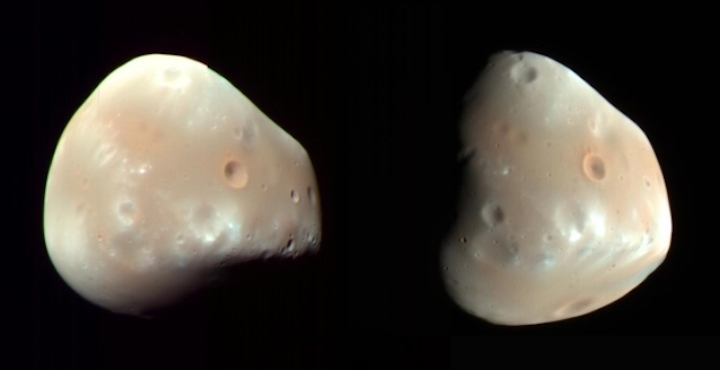13.03.2021

A new theory for the mysterious origins of Mars’ two tiny moons Phobos and Deimos has been developed by Amirhossein Bagheri and colleagues at ETH Zurich in Switzerland and the US Naval Observatory. The team used a combination of data and modelling to conclude that both moons may have come from the same body, which formed alongside Mars before breaking apart. Their model could soon be improved with the help of Japan’s upcoming Martian Moons Exploration mission, due for launch in 2024.
Of all the moons in the solar system, Phobos and Deimos are among the most enigmatic in origin. With their irregular shapes, cratered surfaces, and diameters of just 22 km and 13 km respectively, the pair are commonly believed to be asteroids pulled in by Mars’ gravitational field. However, they also follow highly circular orbital paths, which lie almost perfectly in Mars’ equatorial plane. These paths would be highly unlikely for randomly captured asteroids, suggesting instead that Phobos and Deimios formed alongside Mars.
Yet one further aspect of their orbits, relating to their widely differing orbits, mean that this theory is also problematic. Notably, Phobos orbits well beneath Mars’ synchronous radius – the point at which a moon’s orbital period perfectly matches the rotation of its host planet. Meanwhile, Deimos orbits well beyond this point. These factors make it difficult for astronomers to explain how Phobos and Deimos could have formed at the same time as Mars.
Tidal interactions
Bagheri’s team explored the problem from a new perspective: this time, accounting for the energy dissipated during tidal interactions between the three bodies. To determine how these interactions would affect the orbits of Phobos and Deimos, the researchers used the latest geophysical data for Mars, gathered by NASA’s InSight mission. They also combined these data with both lab-based and theoretical models describing Mars’ tidal deformation.
Based on their results, Bagheri and colleagues conclude that Phobos and Deimos may have both originated from a single body – which formed alongside Mars at a roughly synchronous radius, before breaking into two parts. To explore this idea, the researchers used simulations to turn back the clock on the orbits of both moons.
This revealed that after breaking away from Deimos, Phobos would have initially had an elliptical orbit, which became increasingly circular due to tidal energy dissipation. As this happened, Phobos would have moved beneath Mars’ synchronous radius, reaching its current path after roughly 2.7 billion years. Meanwhile, Deimos would have had a more circular orbit from the start, meaning not enough energy was tidally dissipated to drive the moon under the synchronous radius.
This theory offers key clues about the futures of both bodies. While Deimos will likely continue to recede from Mars, Bagheri’s team predict that Phobos will continue on its inward spiral; eventually either crashing into Mars, or tidally disintegrating into a ring in roughly 39 million years. The proposal is still far from complete, but crucial new insights could soon be gathered by the Martian Moons Exploration – which will collect samples directly from Phobos, and make flyby observations of Deimos.
Quelle: physicsworld

